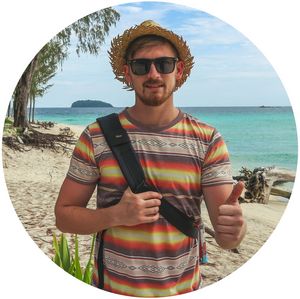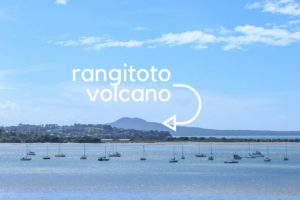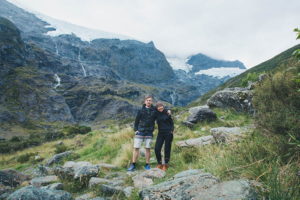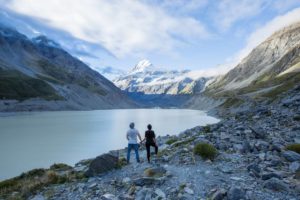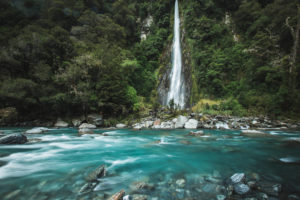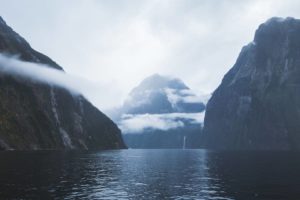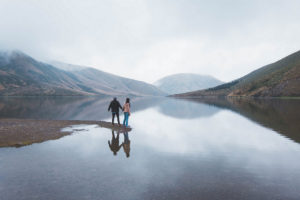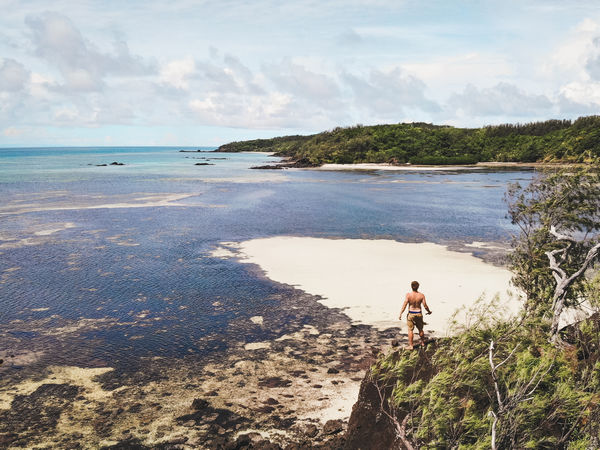Nine Beautiful Islands In New Zealand’s Hauraki Gulf
– Nathan Hayes, for The Commoner
It was hot, so bloody hot. I expected the blazing sun to melt the dark basalt crumbling underfoot, wondering if lava might once again spill out of the earth and tumble down broad slopes into the gulf. Yet for the lush scrub growth spreading out in every direction, this grave expanse of black and gray and reddish browns was muted by the bright greens and yellows of thousands of leafy fingers. The air was heavy that not even a rousing sea breeze could cool us, sweat dripping from our brows and sizzling on the rocks and gravel we stood on.
I squinted into the merciless sun, looking upward toward the overlook we’d ascended not twenty minutes earlier. Impressed, we recalled our climb up the steep wooden walkway. We had carried young Charlie and Colden, whose young bodies had collapsed under themselves in the humid air, steepening every step. But the view corrected every wrong committed by this wilderness. We had been reminded of the cool gulf which surrounded us. Now far below the overlook, the gulf was once again forgotten as all we could see was volcanic rubble, enclosed by a dense bush. At the height of summer, Rangitoto is a monster.
Rangitoto Island rests alongside a plethora of other islands within in New Zealand’s Hauraki Gulf. This large body of water gashes New Zealand’s upper North Island, expressing the country’s violent tectonic past. In fact, depending on which side of the scientific community you find yourself on, it is theorized that the New Zealand landmass is the central ridge of a previously unknown ‘drowned’ continent, named Zealandia.
The Hauraki Gulf is framed by Auckland’s Waitemata Harbour in the west, the Hauraki Plains to the south, the protruding Coromandel Peninsula in the east, and the Barrier Islands to the north. Islands of many sizes, shapes, and terrains populate the gulf, each hosting a unique experience for eager visitors. Of special interest are the inner islands of Motuihe, Rangitoto, Motutapu, Rakino, Waiheke, and Rotoroa, and the outer islands of Tiritiri Matangi, Kawau, and Great Barrier. These islands carry a special connection to the people of New Zealand, crossing over cultural, economic, and social boundaries. By spending even a few days exploring the Hauraki Gulf, you too will encounter an unexpected connection.
Accommodation in the Hauraki Gulf
There are plenty of places to stay in the greater Auckland region, with familiar services like Airbnb and Vrbo, as well as the NZ-specific holiday houses and bookabach (operated by HomeAway). Booking a ‘bach’ is a perfect segue into the Kiwi colloquialism for vacation or holiday rental property, which is referred to locally as a bach – pronounced batch – and is typically a modest house in a popular vacation/holiday spot. This may be a beach house or country home, and may sleep anywhere from 2-20 people, depending on what you consider a bed!
It should also be noted that a hut is different from a bach. Where a bach is likely to have electricity, indoor plumbing, and running water, a hut is a primitive structure found along a hiking trail. It may have solar-power, gas-fired cooktops, and rain-fed water, or it may simply be an uninsulated structure with a roof.
Islands such as Motutapu, Rakino, Waiheke, Kawau, and Great Barrier feature baches or houses that are available to rent. There is great variety in the size and type of accommodation, so be sure to use whichever booking service you prefer.
Rotoroa Island has two opportunities to stay overnight, either in one of three holiday houses on the island or in the Superintendent’s House, which is a boutique hostel with bunk accommodation for up to eighteen people. The Tiritiri Matangi Island bunkhouse is a rugged overnight if you’re into that sort of thing.
Motuihe, Motutapu, Waiheke, Kawau, and Great Barrier islands allow you to camp at designated sites. You can rent camping gear in downtown Auckland from the likes of Adventure Capital or Auckland Backpacks & Beyond.
Please note, there is no accommodation on Rangitoto or Rakino.
Getting to the Islands Near Auckland
From most places, New Zealand is about as far away as you can get. The expense of flying so far has many visitors considering this destination as a once-in-a-lifetime vacation. Do yourself a favor and employ strategies in your everyday life to stretch your travel budget and maximize your airline miles and points. Don’t just travel to New Zealand once – come back a few times and build on your memories!
Getting to the islands around Auckland depends on which island you’re traveling to. In most cases, area ferry terminals are your cheapest route and will have the most consistent schedules. All of the islands mentioned in this article will have some form of passenger ferry service available, but please check Direct Ferries for exact days/times.
Waiheke Island and Great Barrier Island have vehicle ferries. Check with your vehicle rental company to see if there are any restrictions.
For the most flexible access to islands in the Hauraki Gulf, chartered water taxis and cruises are available at any time and generally from any departure point. These are more costly than the typical ferry, yet are completely adaptable to your own schedule. Otherwise, helicopter and seaplane charters are the most exciting option, allowing you to fully view the island you are arriving to, as well as other features around the gulf. Follow the link to the NZ Department of Conservation’s list of approved operators.
And if you’re looking for deals on accommodation, tours & cruises, restaurants, or other goods and services, most Kiwis use GroupOn and GrabOne.

1. Motuihe Island
School-aged children throughout the Auckland region have benefited from this small, relatively flat island, known for its gorgeous golden-sanded beaches. It’s a perfect little escape for an afternoon or an overnight trip, with locals and visitors arriving at Motuihe Island by sea kayak.
Close to the wharf are the two most popular beaches, located on either side of a narrow spit of land carved up by Takutairaroa Bay and the northern end of Waihaorarangatahi Bay. There are large grassy areas between these beaches that are perfect for picnics, as well as toilet facilities and covered shelters for visitors.
For more secluded swimming, head overland using a tangled network of grassy herd paths towards the southeast end of the island. Here you’ll find beaches at Otamarau Bay and Ohinerau Bay. Along the way, you’ll be exposed to native New Zealand plants, birds, and lizards.
2. Rangitoto Island
Rangitoto is the most iconic island in the Hauraki Gulf due to its nearly symmetrical profile being visible from Central Auckland, the North Shore, and the Whangaparaoa Peninsula. Of all of Auckland’s forty-eight volcanic cones, Rangitoto is both the youngest and largest, dating from only 600 years ago and rising 850 feet (260 meters) above sea level. It is an otherworldly landscape that begs to be explored, featuring lava fields, lava tubes, and a variety of leafy plants.
The ascent to the top of the volcano cone is made easier by a 300-step boardwalk that slices through the dense bush and weaves past lava flows. The view from the top gives 360° views of the Waitemata Harbour, including nearby islands, the North Shore, and Central Auckland.
Once you’ve descended the cone, a 4WD tractor train will drive you around the island where you can see more lava types and get a better sense of the size of Rangitoto. Take lots of water as it is a hot and rugged landscape.
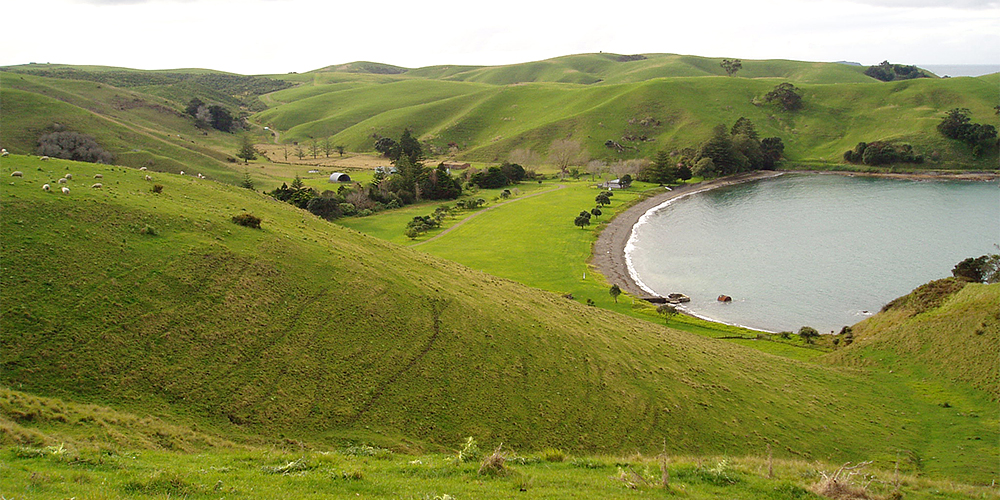
3. Motutapu Island
Connected to Rangitoto via an earthen causeway since WWII, Motutapu Island is much older than its neighbor and features a completely different landscape than the harsh basalt of Rangitoto.
Motutapu Island has a long history of human occupation from the Māori in the 15th century, to Europeans in the mid-19th and 20th centuries. Its rich soil made it a perfect location for farming, so much so that nearly all of the forested regions of the island were cut down in favor of farmland. The Reid Homestead at Home Bay on the eastern side of the island dates back to 1901 and offers a restored vignette into early 20th century New Zealand agrarian life.
Motutapu Island is well known for camping but is a great place to go hiking. Several easy-to-moderate trails will take you to scenic overlooks, beaches, and points of historical interest. Directly east of the Matutapu Outdoor Education Camp is a hub of WWII gun emplacements, located atop a grassy hill, facing northeast towards Rakino Island. Beaches at Sandy Bay in the west, and Station Bay and Mullet Bay in the east are well worth the hike. Tracks to Billy Goat Point in the north and Emu Bay/Emu Point in the south are Instagram-worthy views of the gulf.

4. Great Barrier Island
For visitors who want to get off the grid, Great Barrier Island is the answer and is accessible either via a 5-hour ferry or a 35-minute flight. This is the most distant of the islands near Auckland, but well worth the trip. With around 950 permanent residents spread over 110 square miles, it is the most rugged and ruthless island in the Hauraki Gulf where little contact with other humans is entirely possible. Several tiny towns dot the island where it is possible to get a hot cup of coffee and a meal.
The two main towns are Tryphena and Port Fitzroy, both of which have wharves with ferry access to Auckland, where you can transport your vehicle. Or, save some money and rent a vehicle at Medlands Car Rentals in Tryphena, or Barrier Car Rentals in Port Fitzroy (as well as Claris & Okiwi Airport).
In 2015, the Aotea Conservation Park was opened on Great Barrier Island, which accounts for over 45 square miles of land. The Aotea Track is the only multi-day wilderness walk in the Auckland region, and hikers can find respite at any of the primitive campsites or the two NZ DOC huts – Mount Heale Hut and Kaiaraara Hut – both of which need to be booked in advance. There are over 15 miles of hiking paths throughout, for any experience and fitness level.
There is an easy trail to Kaitoke Hot Springs where thermal water ascends to the surface from deep in the earth. You can reach the springs from Whangaparapara Road. Stick your feet in for a relaxing dip. Please carefully consider the warning signs for amoebic meningitis and do not submerge your head or drink the water.
For more experienced hikers, the route to Mount Hobson/Hirakimata (627 meters high) along Palmers Track is an awe-inspiring hike with fantastic views from a ridgeline traverse. From Aotea Road, this track passes through Windy Canyon, climbing up a series of wood and gravel box steps.
Some of the most notable beaches on Great Barrier are Kaitoke Beach and Medlands Beach, located south of the Great Barrier Aerodrome. There are quite a few short term rental properties in the area as these are a great spot for swimming and kayaking. The beaches at Okupu Bay on the west coast are smaller, enclosed beaches with typically calmer waters. To the north, the secluded surf beach at Whangapoua Bay is accessible by pulling off of Mabey Road for the day, staying at the Whangapoua Beach Front property, or by camping at the primitive Whangapoua Beach Camping Area (NZ DOC). Many other beaches are speckled throughout the island, making this destination a watersports haven.
At the end of your day on Great Barrier Island, simply spread a blanket on the ground and stare off into the night sky. The island has been designated as one of only a couple Dark Sky Sanctuaries in the world, making it one of the best places in the world for star-gazing. Far away from the lights of Auckland, minimal light pollution equals a nightly showing like no other.
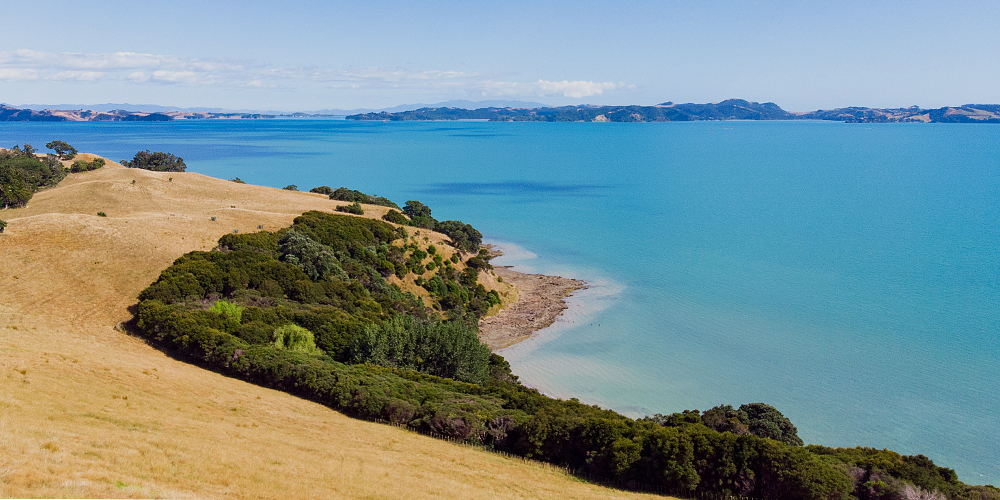
5. Rakino Island
For visitors who prefer isolation, Rakino Island offers just that, with a very small permanent residential population of 20+ people. Electricity to the residences is limited and mostly solar-powered. Residents manage their own drinking water, supplemental food, and waste.
During the warmer months, the population explodes to 100-200 due to a large number of short-term rentals available on the island.
The island draws visitors who are interested in self-sufficiency and a slow lifestyle. A large amount of New Zealand native birds have been self-populating since Rakino was declared pest-free in 2002. It is also known as a great fishing spot, evident by a large number of boats seen in the protected coves around the island.
Most of the beaches on Rakino Island are only accessible from private land or by boat. Sandy Bay and Home Bay are near the Ferry Terminal and are accessible to the public. Both are a great place to chill. Alternatively, take the West Bay Public Walkway heading down the hillside to the tree-filled West Bay. This shore point is initially quite rocky, then suddenly opens up to a lovely stretch of sandy beach.
 6. Waieke Island
6. Waieke Island
For an entirely different gulf island experience, spend a day on Waiheke Island, whose ample amenities and transportation options make it possible for Kiwis to live on Waiheke and commute to Central Auckland, daily. There are also a variety of places to stay overnight if you wish to extend your time there. The ferry ride is just long enough to give you a clearer perspective of the Waitemata Harbour and the greater Hauraki Gulf.
Upon arriving, a bus will transport you up to the small town of Oneroa. The bus service has different options for passes, which can be purchased at the island’s ferry terminal. Or, if you’ve ferried your car over from Half Moon Bay, head into town to get a better lay of the land. The beach at Oneroa is a broad stretch of sand at the end of a beautiful inlet. The town itself is a quintessential beach town, featuring a mixture of artisan/craft shops, fashion boutiques, and eateries of all types and budgets. Most restaurants will have a back deck with views out to Oneroa Bay.
You could easily spend an entire day in Oneroa, or set out to one of the other smaller towns. Onetangi can be reached via bus, but only has one or two places to grab drinks or a meal. This is the tradeoff for being less crowded. Or head to the secluded Palm Beach, which is much more residential.
Waiheke is home to many wineries and vineyards in beautiful surroundings. The combination of volcanic soil, rain, and sun has resulted in a growing wine industry. Each one can be reached via bus or an established wine tour.
Waiheke is also a great place for outdoor sports. It is common to see people biking around Waiheke Island, though the rolling hills and curvy roads will test one’s mettle. To rent bikes on the island, connect with the folks at Bikes & Barbers, located at 108 Oceanview Road in Oneroa. Hiking and camping are also quite popular. The hiking trails found throughout the island offer solitude, tranquility, and biodiversity, and cover a wide range of grades and levels of experience.

7. Rotoroa Island
For a small island, Rotoroa is oddly well established, with several outbuildings offering accommodation and/or historical interest. As a rehabilitation facility for alcoholics, the island has seen institutional use from 1911-2005. During this time Rotoroa was largely self-sufficient, existing as an early model of sustainability. Since then, the island has pivoted to become a sanctuary for New Zealand native species of flora and fauna, alike.
The appeal of this small island suits visitors with a multitude of interests. Like so many other islands across the gulf, Rotoroa has a lot of hiking trails which showcase the Instagram-worthy landscape. In recent years, a variety of art displays have appeared on the island, including photography and large sculptures. The award-winning Museum and Exhibition Centre teach visitors about the alcoholism facilities as well as other island histories. Or, for something a little different, sign up for one of the Public Volunteer Days and be part of the gulf’s ecological plan.
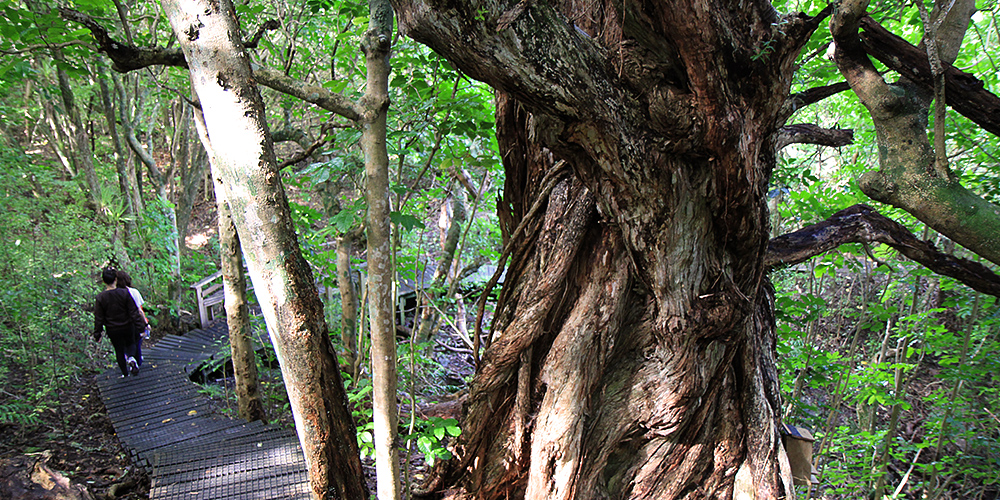
8. Tiritiri Matangi Island
Tiritiri Matangi Island is a gorgeous wildlife sanctuary for native New Zealand birds. Plan to spend an entire day here, with plenty to keep you busy.
The island is crisscrossed by hiking trails, which range from wide grassy pathways, wooden boardwalks cutting through native bush, and tight descents to hidden rocky coves. The eastern side of the island has been more affected by the gulf winds, creating a violently beautiful landscape draped in lush greenery.
While there, you’ll be captivated by the birdlife that calls this island their home. With no known predators, these native species have flourished. The island is also home to a vast amount of native plants indigenous to the region. Other notable points of interest are the small duck pond towards the southern end, the lighthouse, and the Visitors Center & Gift Shop. There are several rocky shores that are swimmable, but the sandy Hobbs Beach is much more protected and perfect for anyone to enjoy.
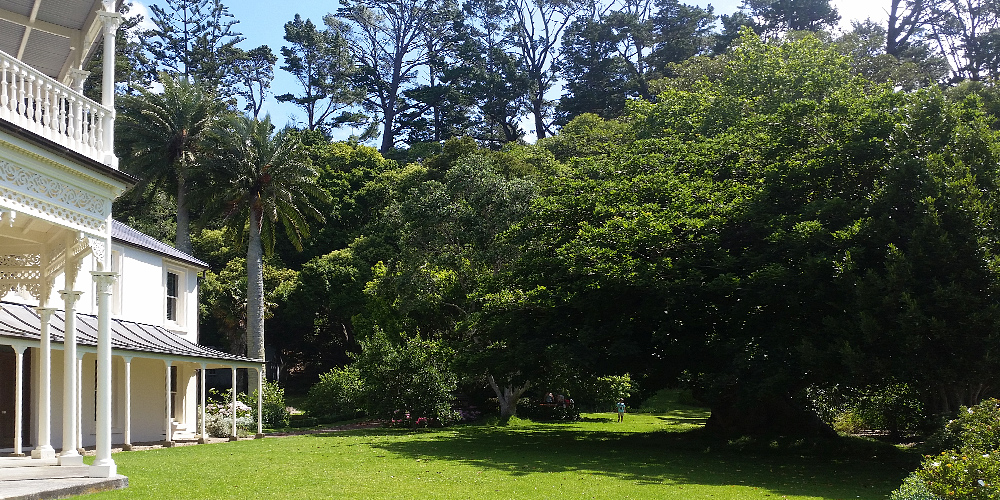
9. Kawau Island
As one of the largest Hauraki Gulf islands, Kawau Island is a true gem that you just have to experience to fully understand. For the size of the island, only 75+ residents call it their permanent home, owning 90% of the land. The remaining 10% is owned and maintained by the NZ DOC, including the historic Mansion House on the western side of the island.
At only one hour from Auckland, the Ferry Terminal at Sandspit makes Kawau an easy day trip or a fun multi-day stay. Like Waiheke Island to the south, Kawau Island has a fair amount of short-term rental properties as well as opportunities for hiking and camping. It is a rugged landscape, filled densely with native bush covering cliffs and hills rising 182 meters above sea level.
Though it is not yet considered pest-free, Kawau is home to several species of kiwi and an estimated 65% of all of the North Island weka, another native flightless bird. Many visitors flock to the island just to bird watch. And this includes the non-native peacocks which roost in the reserve at the Mansion House.
Kawau Island is a favorite among New Zealanders for fishing and boating, as waters between the island and the mainland are generally calm and clear. It’s very typical to see various coves and bays around the island completely filled with small boats. With several cafes on the island, it’s not uncommon for boaters to come ashore for a nice meal and a good coffee.
Know Before You Go
Each of these nine islands near Auckland in the Hauraki Gulf is different in their own way. With a little planning, you can connect on a deeper level to the cultural, economic, and social landscapes which populate these fascinating retreats.
Many of these islands are pest-free sanctuaries for New Zealand native bird and insect populations, and the NZ Department of Conservation (DOC) is very careful on how these islands are treated. Certain islands will have carefully laid out restrictions on what you can bring with you, especially if you are planning on staying overnight. Be ready to go through a biological inspection at the arrival terminal. Check with the DOC while planning your trip.
When visiting the more rugged islands, it’s a good idea to treat it like a camping trip without the camping part (unless you plan on actually camping). Wear solid sneakers or hiking boots and carry a small daypack with plenty of drinks and food. Some of the islands, like Waiheke Island and Great Barrier Island, will have places to purchase anything from a cup of coffee to full 3-course meal. But many won’t even offer a vending machine, like Tiritiri Matangi Island. If taking a ferry or water taxi, be sure to inquire whether or not these services have an on-board cafe or snack bar. Or simply bring your own supplies.
Most of the islands have miles of hiking trails available to you, which may go over state-owned land or private land – in either case, be respectful and carry out your own trash. The grades of each trail will vary greatly, from the steep trails on Great Barrier Island to the gentle stroll around Motuihe Island.
If traveling during winter (June to October), expect there to be some muddy spots as Auckland can be very rainy. I’d also advise taking sunblock, lip balm, hand/face lotion, a hat, and sunglasses, even if you’re visiting during the winter. A light rain jacket is also a good call. The ozone layer above New Zealand is very thin, making it easier to get sunburn. You’ll also be exposed to incredible gulf winds – a little lip balm goes a long way!
If you’re planning on swimming, be careful wherever large rocks and cliffs are present. Strong waves can knock you into these rocky outcroppings, leading to any level of injury. Access to secluded beaches may take you down steep inclines and falls from height are possible. It is important to be careful and play smart, especially since you will be further away from rescue services.
And seriously, bring some bug spray for the sandflies.
Author Biography:
Nathan Hayes is a traveler, storyteller, and photography enthusiast. In 2017, he co-founded Flying Fenix Media and created The Commoner – a multi-author online travel magazine which specializes in hidden gems across the USA. His varied writing experience and formal education in Acting and Directing give him great insight into contemporary story-telling. In his role as Editor-in-Chief he is responsible for the voice and tone of The Commoner, which features local perspectives. When he is not working on The Commoner, he is working as a Project Architect at a Washington, DC area multi-family architecture firm, chasing his four children, and planning hiking trips in the Adirondacks of northern New York.
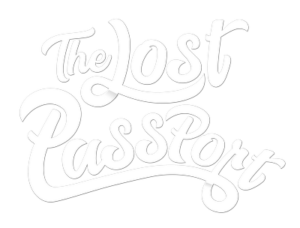
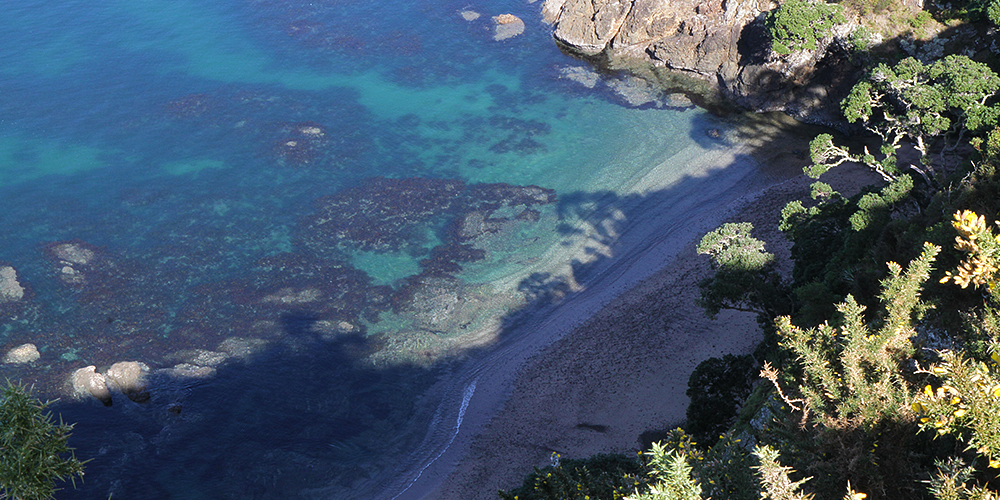
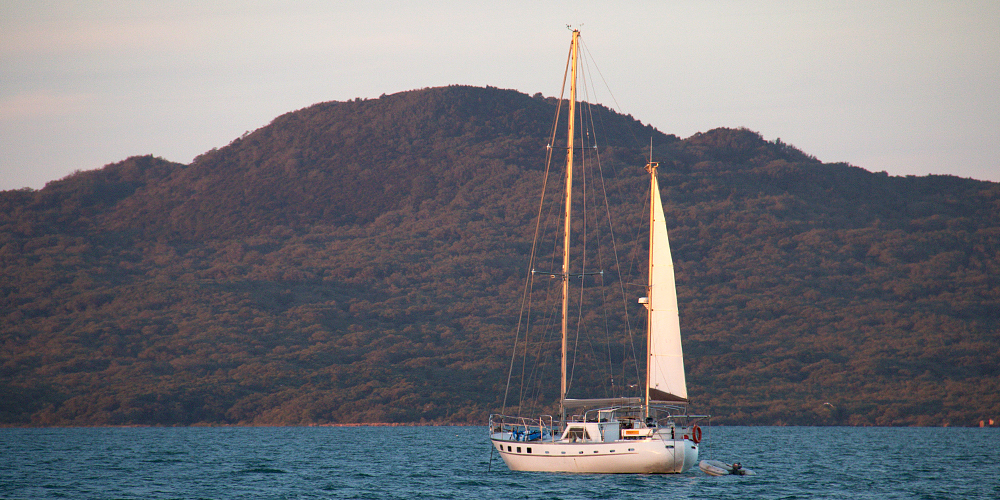
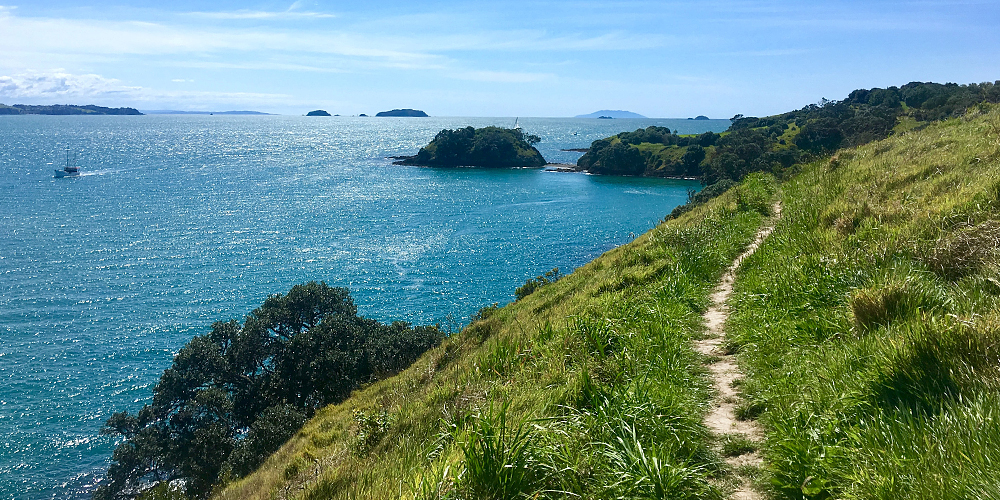 6. Waieke Island
6. Waieke Island